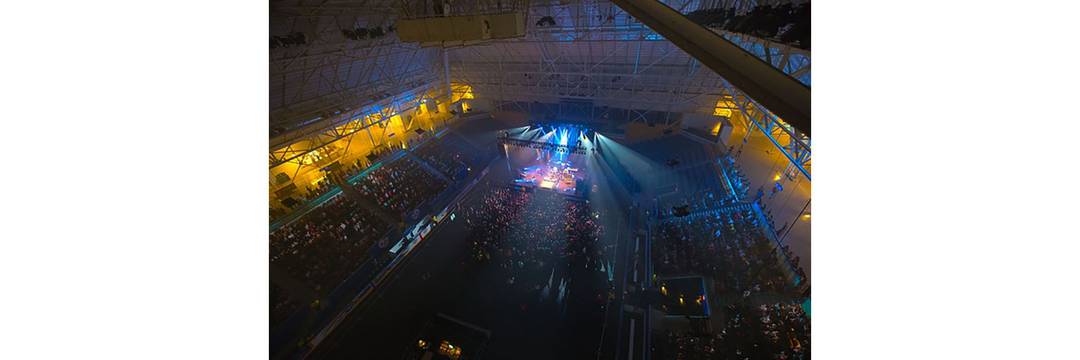
Historic Canadian Hockey Shrine Reopens with Q-Sys™ Network Infrastructure
Features Three Q-Sys Core Processors Which Provide Flexible and Scalable DSP Audio Networking and More than 32 QSC Amplifiers to Power the Loudspeakers
Toronto, Ontario, Canada (September 19, 2013) —Toronto’s historic Maple Leaf Gardens was gutted in 2010 and the interior completely rebuilt over the last few years, reopening as the Mattamy Athletic Centre (MAC) at the Gardens and featuring a brand new audio network infrastructure driven by three QSC Q-Sys™ Core 1000 processors and more than 32 QSC amplifiers to power the loudspeakers. The multi-purpose, four-story building now houses a 70,000-sq.-ft. Loblaw’s food store at street level with Ryerson University’s new 222,970-sq.-ft. sports facilities, including an NHL-sized ice hockey rink, multi-purpose courts and other amenities, on its upper levels.
Originally built in 1931 and known as Canada’s “Cathedral of Hockey,” the venue is revered as the historic home of the Toronto Maple Leafs team, and was added to the Canadian Register of Historic Places in 2009. The arena was home to the Maple Leafs from 1931 through 1999, during which time the team won 11 of its 13 Stanley Cup championships.
Devy Breda, CET, CTS, senior AV systems designer with Mulvey Banani International Inc. (MBII) of Toronto Ontario, elected to use the Q-Sys Core 1000 processors—the first Q-Sys units to be installed in Canada—to provide flexible and scalable DSP audio networking and signal distribution. Q-Sys manages the sound reinforcement system in the 2,600-plus-seat ice rink, provides zoned paging to all of the installed sound systems in the MAC and facilitates room combining in the conference suites, while also allowing for future expansion.
This was truly a landmark project for Breda. “You’ve got to understand the excitement on my part, the emotional side. This was Maple Leaf Gardens! I had to make sure that I did it right. So I didn’t want to go with an end-of-life DSP, because the fear is that two or three years down the road it will be a dinosaur. I had to make sure I used technology that’s future proof—and Q-Sys is a fresh product. I have confidence in the brand because I had strong, positive experiences with QSC when I had my own contracting business. So I felt that Q-Sys was the right direction.”
The three Q-Sys Core 1000 processors manage three main zones in the MAC’s upper floors: the ice hockey arena; the 1,000-seat Coca-Cola Court, which hosts basketball, volleyball and other sports; and the remainder of the public areas, which include a fitness center, gymnasium, studios and meeting rooms. The three Core 1000 processors and four I/O Frames are located in various rack rooms on the second and fourth floors and in the arena control room.
“Since this is essentially new construction there were no wiring restrictions,” says Breda. With no wiring restrictions in place he was able to specify a fiber infrastructure using Allied Telesis switches for the audio network. “I looked at fiber because that gives me the best-in-class backbone for transporting audio through the facility and extending it out to a broadcast truck point,” he explains.
More than 32 QSC amplifiers were also installed at the Mattamy Athletic Center. 20 QSC CX902 and four CX602V two-channel amplifiers power the installed speakers in the ice hockey arena and the gym. Eight QSC CX204V four-channel amps drive the MAC’s various 70V distributed audio systems. “QSC amplifiers were a good fit for this project,” Breda comments. “When I looked at Q-Sys, the CX series and the DataPorts, it was all there—a holistic marriage.”
Toronto-based show services and AV systems integration firm Westbury National, under the direction of project manager Scott Wouters, installed all of the MAC facility’s AV equipment.
According to Breda, the audio systems in each of the three areas can operate independently. “Paging is matrixed within that; reception or the front desk can page into any zone including those spaces. In each space you have a complement of microphone and line inputs and outputs for plugging in sources and sending signals to media or broadcasters. There are panels at strategic places within each of those spaces for a multitude of I/O, both analog and digital.”
He adds, “The technology employed is adaptable and can be easily reconfigured for other events and uses: the resources Q-Sys provides are a great foundation for a complex system design.”
About the Mattamy Athletic Centre at the Gardens
The Mattamy Athletic Centre at the Gardens features an NHL-sized rink on the third floor, a second-level multi-purpose court, a fourth-level lounge overlooking the ice and a third-level lounge overlooking the court. The venue also offers several multipurpose meeting rooms, a state-of-the-art fitness center on the second level with an adjoining café, and fourth-level concourse space. Facilities are open to the community and the amenities are available to rent.
The largest arena in Canada when it was built—in just seven months—in 1931, Maple Leaf Gardens has been making history ever since. In 1946 it hosted the first NBA game and in 1948 was host to the first official NHL All-Star game. Over the years it has hosted events with Winston Churchill and Mohammed Ali; Elvis Presley played his only show outside the United States at the Gardens in 1957; and it was the only venue at which the Beatles performed on each of their three North American tours. Since 1931 the Gardens has been a home to two soccer teams, two lacrosse teams, five hockey teams and three basketball teams.